Last year, the pandemic restricted many from their planned vacation destinations. In defiance, many non-RVers chose the open road, purchasing all types of RVs in record numbers. I ran into one such guy last fall. This newbie to RVing purchased an older motorcoach that had sustained inside floor and lower wall water damage. After showing me pictures of his project from his iPhone, I asked him how he came about this beauty, knowing how water damage could become a nightmare.
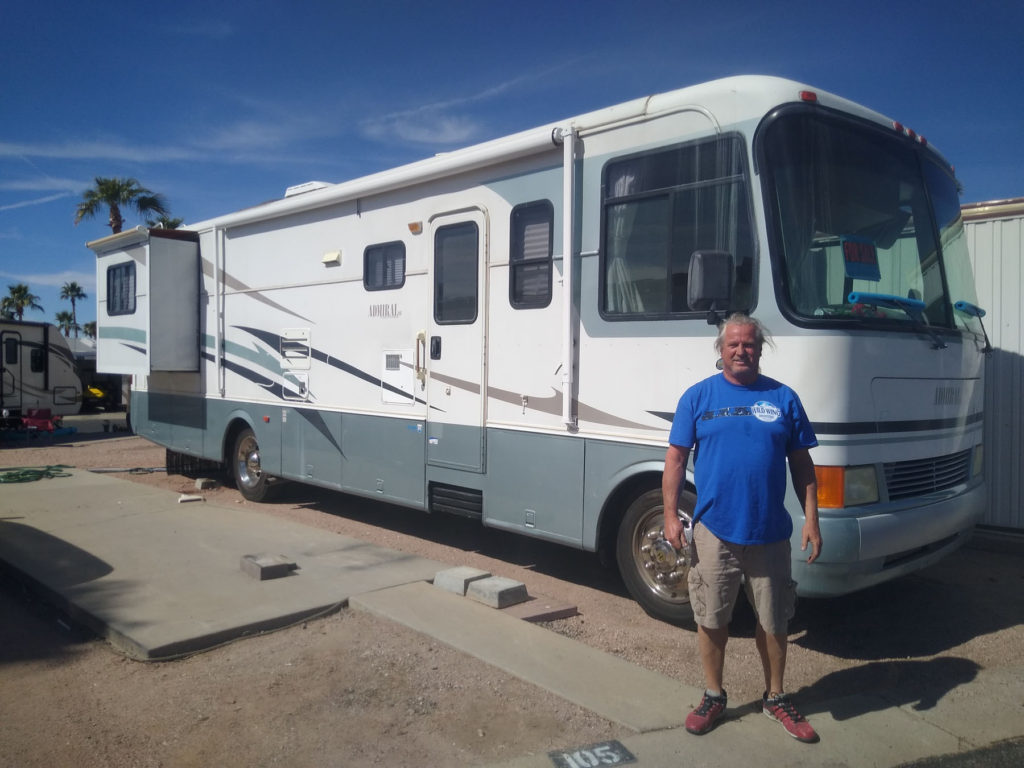
What an undertaking
A newbie who was about to become a workcamper, owner, Jeff Johnson, said he located this 2004 36’ Holiday Rambler motorhome on the internet last October. He flew to Richmond, Virginia to check it out, confessing, “It was a bank repo. The price was right! I expected to spend about $15,000 more and it’d still be worth more than what I have in it.”
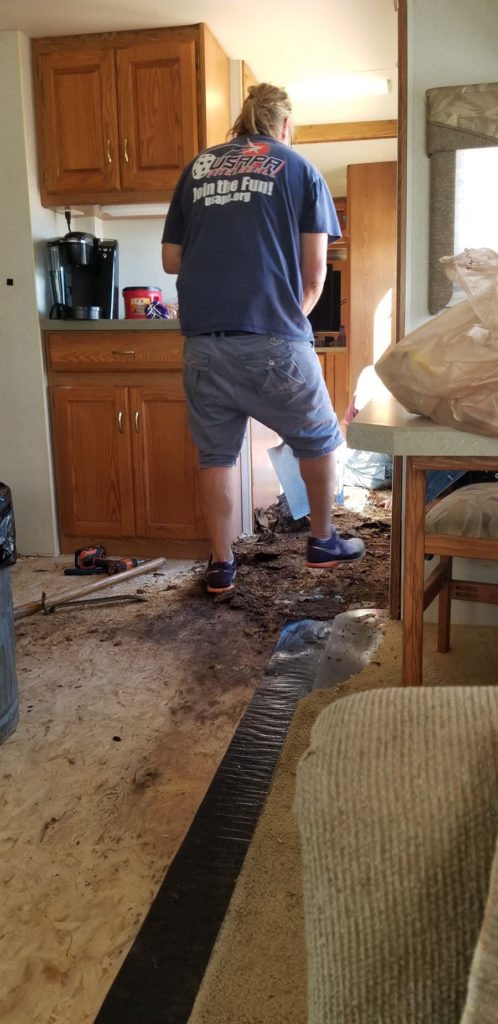
DIY handyman experience helps
Jeff fit the handyman profile. A DIY guy. I asked him to what depths he had to go to remodel his coach. I’m guessing these pictures speak for themselves. He said, after demolishing the floor and removing all traces of mold, he walked on planks for at least two weeks while the floor structure dried. “Then,” he said, “I put down marine grade plywood as the underlayment using angle iron brackets and rebuilt the floor entirely of laminated wood. No carpet anywhere.”
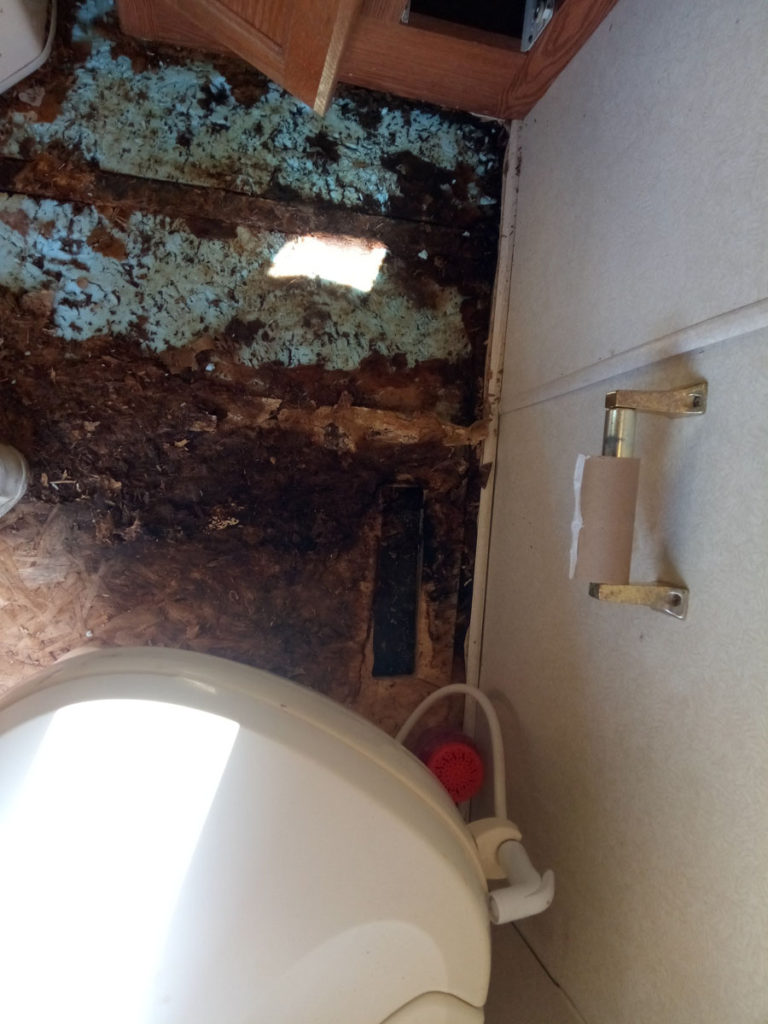
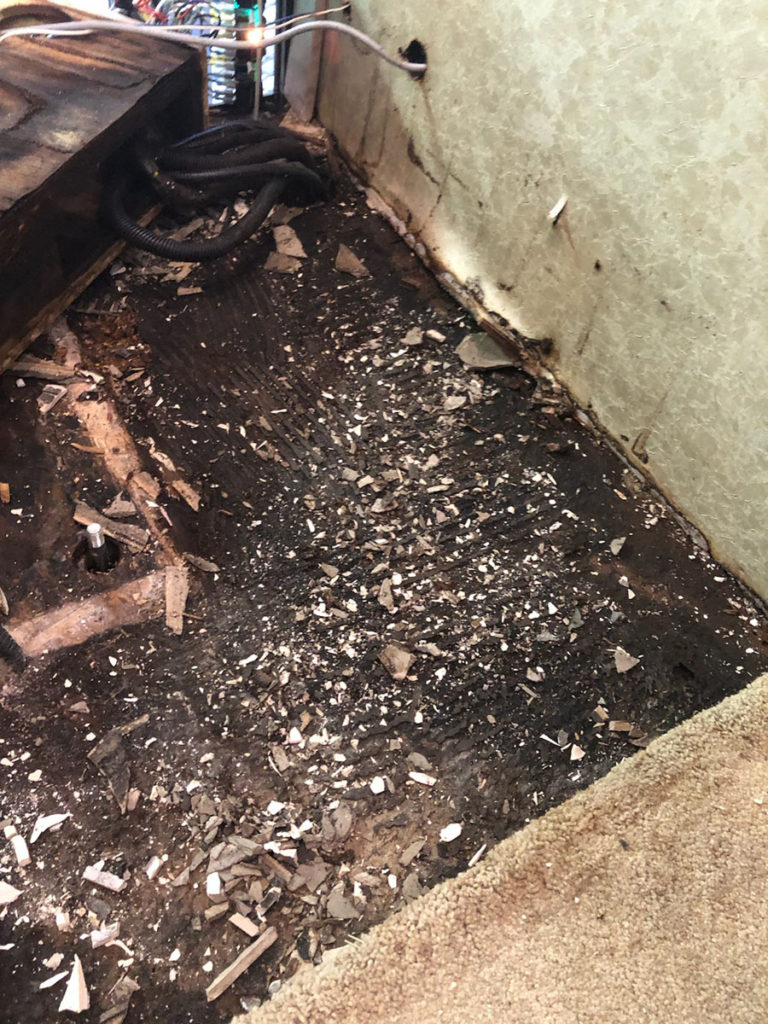
After he was well into his demolition, Jeff hinted that it looked as though the water leak may have started in the bathroom which was why the cabinet was completely soaked and full of mold and it likely migrated into the mid-coach kitchen area. He said, “I just trashed the cabinet. It wasn’t worth trying to refinish. Instead, I found one that fit perfectly along with parts from a RV junkyard. All I had to do then was strip the old color, sand it and stain the cabinet to match the color.”

A heck of a project for $25,000
Jeff admits today, it was a ‘heck of a project’, taking some two months to complete while work camping, finishing the project with new window treatments just before Christmas.

Let’s step this up a notch. Say you’ve talked about some upgrades or even customization. You’ve got ideas. So where do you go? If you haven’t already accomplished the project yourself, it may be safe to say it is time to do some homework.
Three years ago, we began researching motorhomes. We knew we wanted at least a 40’ diesel pusher. Flying our plane gave us the ability to visit dealerships, attend regional RV shows, listen, learn and ask a ton of questions. One recommendation from several full-timers restated often was, “You should take a tour and watch a Tiffin motorhome being built. It’s a real eye opener.” We contacted Tiffin and scheduled a visit the following week in Red Bay, Alabama. While there, we learned as much about what to look for as well as the myriad of cottage industry facilities that support coaches older than ten years.
Tiffin supports a cottage industry for RVers
In fact, last month in an interview with Bob Tiffin, CEO of Tiffin Motorhomes, he reiterated more about the cottage industry of qualified folks to work on motorhomes and RVs. In our conversation, he rattled off ten support facilities faster than I could write them down, mentioning toppers and paint on the outside to everything inside. One thing stuck out in our conversation when Bob emphasized the significance of an experienced cottage industry wholeheartedly supported by Tiffin. Many of these businesses started from employees who worked at Tiffin. Bob said, ”If you need something done for your motorhome or RV, you’ll find it within 30 minutes of Red Bay.
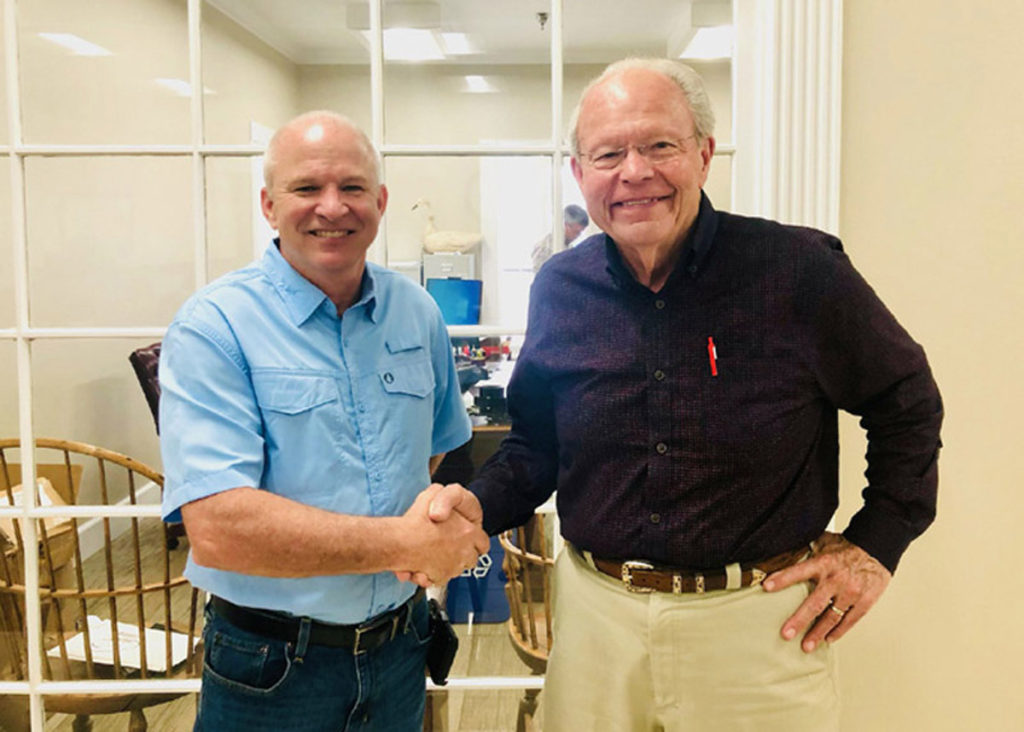
Qualified support for RV repair and maintenance
Having dealt with Bob Tiffin personally on a matter regarding our Phaeton, Bob did not mince words initially recommending Nathan Davidson who co-founded Lakeshore Custom RV in Iuka, Mississippi in 2018. And now, Nathan has opened Davidson RV in Belmont, Mississippi, closer to Tiffin in Red Bay, Alabama. Bob joked when he said, “Nathan initially was farther from Red Bay, but at the top of the list. I found Bob’s nonchalant honesty refreshing. That represented how we have been treated time and again by Nathan and Brian.
Why is a qualified facility important? Even Bob reminded me that service is key, especially when it bears the Tiffin name. That’s why he reiterated that Nathan worked in every department. For seven years, he inspected and tested everything electrical and plumbing, ending in structural frames, cabinetry and finally spent five years setting up service centers for Powerglide, Freightliner, Spartan and Ford chassis. All seventeen years prior to co-founding Lakeshore Custom RV with Brian Robinson, active NHRA car racer in 2018. Both Davidson RV and Lakeshore can repair/replace and customize your bumper trailer, 5th wheel or motorhome’s interior, front to back, as we have customized our Phaeton from appliances and interior upgrades. Sans actual engine work, there’s not much we haven’t explored with Nathan, garnering new customization ideas each time we get together.
The all-important question
Would you invest in a water-damaged RV? If you consider doing so, here’s a few tips from Nathan to watch out for:
Exterior
When looking at the exterior of an older coach that has sustained water damage the main issues to look at are:
- Delamination of the fiberglass on the exterior of the coach. This will appear as waves, buckling and may protrude out. This is due to the separation of the fiberglass from the laminate material in the wall. This is very costly to repair.
- Rust on the trailer hitch, rims, and frame.
- Cracks down the sides or delamination from the top of the roof.
- Seals around air conditioner, Wi-Fi and/or antennae, roof vents, solar panels and skylight (silicone should be supple, not dry, cracked and moldy).
- Roof should be clean and free of oxidation (noticeable after a rain with milky streaks running down the side of the rig.
- Rust around frame, outside of any slides, window frame corners
- Check the generator, inverter and batteries
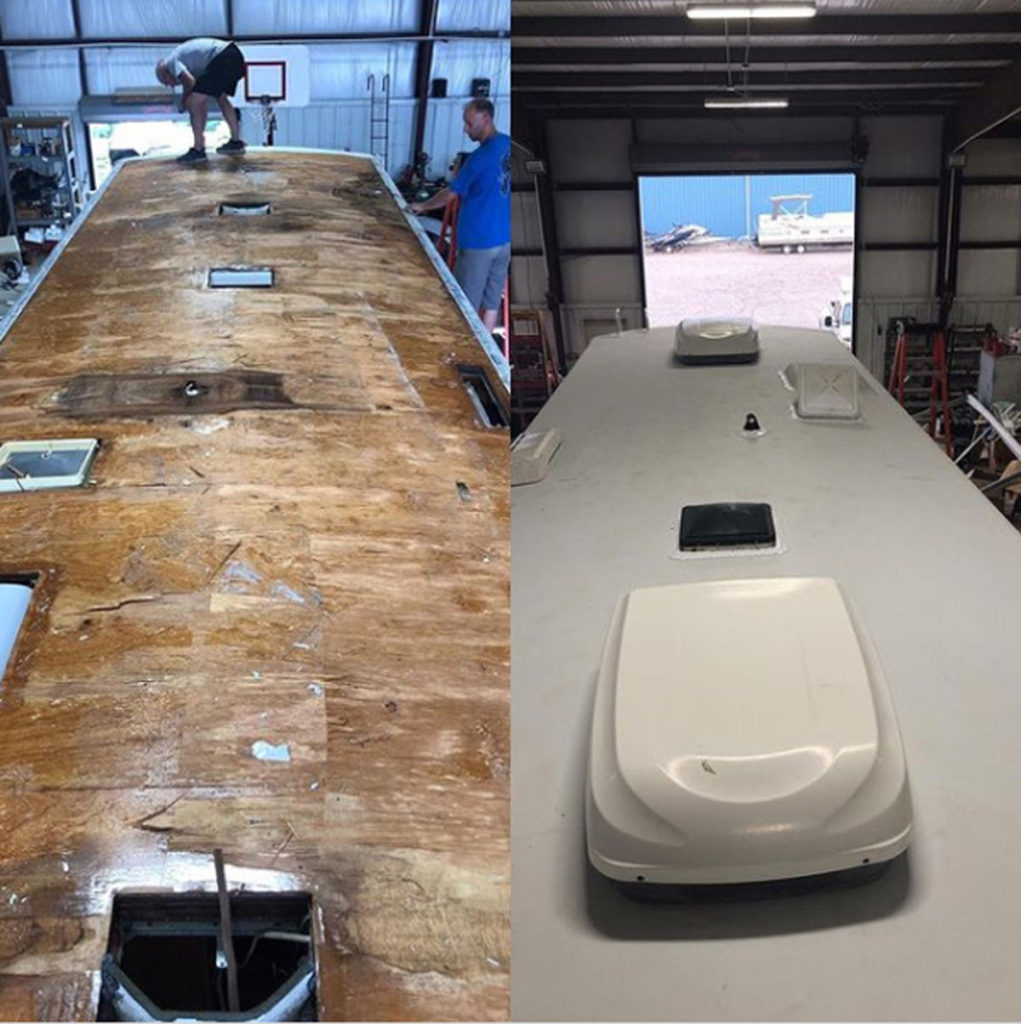
Interior
- A first-time buyer should be very wary purchasing a rig with water damage as most of the damage may be hidden until a problem occurs. That’s when major expenses arise.
- Look around windows for staining and feel for soft spots.
- Check around slide outs for water stains on the carpets.
- Look for waves and/or wrinkles on the ceiling panels
- Brown stains in ceiling panels and lights
- Always trust your sense of smell, because if it smells musty it probably has a leak and has developed mildew or mold
- Cracking or sagging tile. Easily discernable if you step on a soft spot and the floor feels mushy. Older tile is hard to come by for matching, so replacement with new laminated floors is the most common. Subfloors that have water damage can be repaired or replaced quite economically by an experienced installer.
- Sagging or stained ceiling panels require a special mastic glue, not typically off-the-shelf in the big box stores. This is a much more difficult job. Not one for a DIYer.
Read the edited article published April 16, 2021 here:
RV demolition: The quest to renovate a water-damaged junker – RV Travel
Kate Doherty has been writing for more than 30 years in technical and general media. In her previous business, she and her spouse dealt with special projects within the military/government sector. Recently she published “Masquerade: A Logan Scott Novel” under the pen name Bryan Alexander, a thriller now available in eBook and paperback on Amazon. It’s a page-turner!
